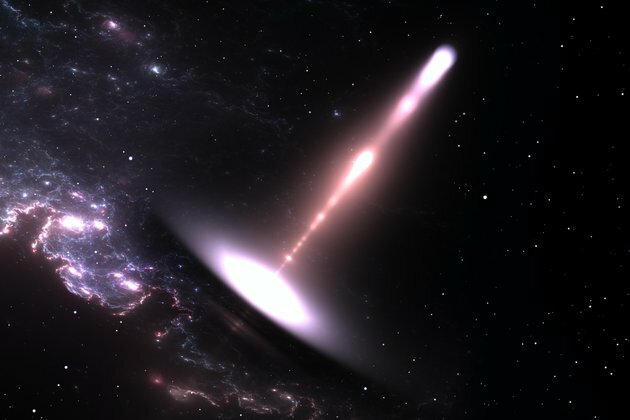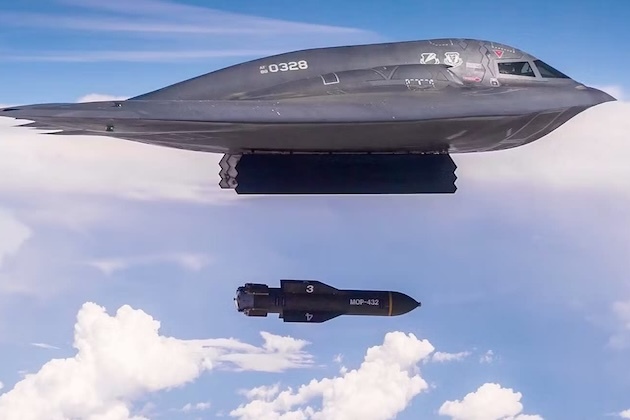Astronomers have detected one of the biggest black hole jets in the sky
The Conversation
19 Aug 2022, 06:08 GMT+10

Astronomers at Western Sydney University have discovered one of the biggest black hole jets in the sky.
Spanning more than a million light years from end to end, the jet shoots away from a black hole with enormous energy, and at almost the speed of light. But in the vast expanses of space between galaxies, it doesn't always get its own way.
Taking a closer look
At a mere 93 million light-years away, the galaxy NGC2663 is in our neighbourhood, cosmically speaking. If our galaxy were a house, NGC2663 would be a suburb or two away.
Looking at its starlight with an ordinary telescope, we see the familiar oval shape of a "typical" elliptical galaxy, with about ten times as many stars as our own Milky Way.
Typical, that is, until we observed NGC2663 with CSIRO's Australian Square Kilometre Array Pathfinder (ASKAP) in Western Australia - a network of 36 linked radio dishes forming a single super-telescope.
The radio waves reveal a jet of matter, shot out of the galaxy by a central black hole. This high-powered stream of material is about 50 times larger than the galaxy: if our eyes could see it in the night sky, it would be bigger than the Moon.
While astronomers have found such jets before, the immense size (more than a million light years across) and relative closeness of NGC2663 make these some of the biggest known jets in the sky.
Read more: Like a spinning top: wobbling jets from a black hole that's 'feeding' on a companion star
Shock diamonds
So, what did we see, when the precision and power of ASKAP got a "close-up" (astronomically speaking!) view of an extragalactic jet?
This research is led by doctoral student Velibor Velović of Western Sydney University, and has been accepted for publication in the journal Monthly Notices of the Royal Astronomical Society (preprint available here). Our Evolutionary Map of the Universe (EMU) survey sees evidence of the matter between galaxies pushing back on the sides of the jet.
This process is analogous to an effect seen in jet engines. As the exhaust plume blasts through the atmosphere, it is pushed from the sides by the ambient pressure. This causes the jet to expand and contract, pulsing as it travels.
As the image below shows, we see regular bright spots in the jet, known as "shock diamonds" because of their shape. As the flow compresses, it glows more brightly.
Biggest one yet
As well as in jet engines, shock diamonds have been seen in smaller, galaxy-sized jets. We've seen jets slam into dense clouds of gas, lighting them up as they bore through. But jets being constricted from the sides is a more subtle effect, making it harder to observe.
However, until NGC2663, we've not seen this effect on such enormous scales.
This tells us there is enough matter in the intergalactic space around NGC2663 to push against the sides of the jet. In turn, the jet heats and pressurises the matter.
This is a feedback loop: intergalactic matter feeds into a galaxy, galaxy makes black hole, black hole launches jet, jet slows supply of intergalactic matter into galaxies.
These jets affect how gas forms into galaxies as the universe evolves. It's exciting to see such a direct illustration of this interaction.
The EMU survey, which is also responsible for identifying a new type of mysterious astronomical object called an "Odd Radio Circle", is continuing to scan the sky. This remarkable radio jet will soon be joined by many more discoveries.
As we do, we'll build up a better understanding of how black holes intimately shape the galaxies forming around them.
Read more: Observing the invisible: the long journey to the first image of a black hole
Authors: Luke Barnes - Lecturer in Physics, Western Sydney University | Miroslav Filipovic - Professor, Western Sydney University | Ray Norris - Professor, School of Science, Western Sydney University | Velibor VeloviУтЁ - PhD Candidate, Western Sydney University 
 Share
Share
 Tweet
Tweet
 Share
Share
 Flip
Flip
 Email
Email
Watch latest videos
Subscribe and Follow
Get a daily dose of Sydney Sun news through our daily email, its complimentary and keeps you fully up to date with world and business news as well.
News RELEASES
Publish news of your business, community or sports group, personnel appointments, major event and more by submitting a news release to Sydney Sun.
More InformationBusiness
SectionFarmers exploit loophole in Amazon soy deal to clear rainforest
SANTAREM, Brazil: As Brazil cements its position as the world's top soy exporter, a new wave of deforestation is spreading across the...
Europe eases rates as Fed holds and Trump threatens tariffs
ZURICH, Switzerland: A wave of central banks across Europe surprised markets last week by lowering interest rates, responding to easing...
Federal Reserve chief weighs next move as economic outlook wavers
WASHINGTON, D.C.: The U.S. economy is performing reasonably well, but Federal Reserve Chair Jerome Powell faces a difficult decision...
TikTok gets US reprieve as Trump grants 90-day extension
WASHINGTON, D.C.: President Donald Trump has granted TikTok another reprieve, extending the deadline for its Chinese parent company,...
Next-gen weight-loss drugs aim to cut fat, spare muscle
WASHINGTON, D.C.: As the global weight-loss market explodes, drugmakers are now racing to solve a less visible problem: protecting...
Amazon’s Zoox unveils plan to build 10,000 robotaxis a year
HAYWARD, California: In a significant step toward its commercial debut, Amazon-owned Zoox has unveiled its first factory dedicated...
International
SectionAssisted dying bill clears key hurdle in UK Parliament
LONDON, U.K.: In a landmark moment for Britain, lawmakers in the House of Commons have voted in favour of legalising assisted dying,...
International law no longer a priority among Western leaders
Western support for Israel's right to strike Iran backs up a pattern of pre-emptive violence that critics say is further eroding international...
Carney sets 30-day deadline for US trade deal
OTTAWA, Canada: Canada may boost its counter-tariffs on steel and aluminum imported from the U.S. if a comprehensive trade agreement...
Leaked call pushes Thai govt to the brink as allies waver
BANGKOK, Thailand: Thailand's government is facing its biggest crisis in nearly a year, as Prime Minister Paetongtarn Shinawatra's...
Trump orders U.S. to join Netanyahu's war on Iran
WASHINGTON, DC - U.S. President Donald Trump how bowed to pro-Israel elements in his administration and Congress, announcing that the...
Swiss National Bank responds to strong franc and US trade doubts
ZURICH, Switzerland: The Swiss National Bank (SNB) lowered its key interest rate to zero percent on June 19 to respond to falling inflation,...













